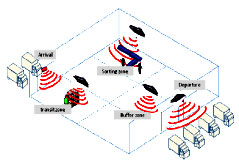An investigation into the key points of an 2.4 GHz RFID-enabled solution and its deployment by China Post in domestic mail quality of service measurement for reliability and cost-effectiveness
by Shanghai Research Institute of China Post
 In order to improve the domestic mail quality of service, China Post required a solution featured with good performance, cost efficiency and easy implementation, and no change or interference in the daily operation. But the world popular solutions could not fully satisfy those requirements due to technical performance and installation problems.
In order to improve the domestic mail quality of service, China Post required a solution featured with good performance, cost efficiency and easy implementation, and no change or interference in the daily operation. But the world popular solutions could not fully satisfy those requirements due to technical performance and installation problems.
RFID technology is emerging rapidly in the postal and logistic industry, and with technological development it will be deployed by more postal operators for quality of service measurement in the near future. In recent years, Universal Postal Union (UPU) has been promoting a RFID-enabled Global Monitoring System (GMS) which ‘measures the quality of service performance in the country of destination of the inbound mail coming from other users of the measurement system’ and terminal dues remuneration shall be based on quality of service performance in the country of destination. 191 UPU members will be invited to join.
This would be considered as the driving power that stimulates world postal operators to improve the domestic delivery performance.
Nowadays a few countries like Deutsche Post, Royal Mail, Saudi Post and Australia Post have already deployed the domestic mail quality of service measurement systems based on RFID technology and achieved good results. China Post, one of the largest postal operators in the world, is serving a huge population scattering in a vast territory.
Due to economic development factors, different areas have different quality of service levels. In order to enhance the nationwide delivery performance, China Post need realize the quality of service level in each province and identify bottlenecks that cause delay or loss in the journey from posting to receiving, and after that improve all the levels of the logistics, such as collection, transportation, production, and distribution. With the increasing requirements from the public about service excellence and gained experiences from other postal operators that implement RFID-enabled solutions, China Post started a considerate process of finding a proper solution a few years ago.
Unfortunately, world popular RFID solutions cannot fully satisfy all the requirements, which impelled China Post to seek a new applicable solution that can measure and improve the domestic quality of service level in the best way.
Requirements
China Post was seeking a solution that could satisfy the following four requirements:
Good system performance
China Post was in need of a solution that could automatically measure the quality of service level for standard letter items of China Post and provide objective results of each province in a reliable way. The solution should guarantee the top-level technical performance under the actual operation conditions, the secure data capture and transmission, and can be used for multiple purposes.
Cost efficiency
 The main concern of China Post is the deployment cost. Statistics reveals that there are around 57,136 post offices in China, excluding hundreds of mail processing sites. The deployment cost would be very high because hundreds of RFID equipments might be needed. Therefore China Post required a cost-efficient solution that could achieve the same performance as other popular solutions used in the world but cost less. No change or interference in the daily
The main concern of China Post is the deployment cost. Statistics reveals that there are around 57,136 post offices in China, excluding hundreds of mail processing sites. The deployment cost would be very high because hundreds of RFID equipments might be needed. Therefore China Post required a cost-efficient solution that could achieve the same performance as other popular solutions used in the world but cost less. No change or interference in the daily
operation – the quality of service measurement solution should not interfere or change the daily work, including operational procedures and the existing facilities. Postal staff could operate as usual with no additional or deliberate work in the measurement process. China Post required that there should be no change or the minimum change in the current postal facilities to install the quality of service measurement equipments.
Easy implementation
Considering a huge number of RFID equipments might be used, China Post required that the solution could be easily implemented without highly skilled supplier technicians and should leave no extra work for China Post staff. Moreover, RFID equipments should be featured with easy installation and simple maintenance.
 To find out a proper solution, China Post started a considerate process of investigation, comparison and selection. In 2008 a three-month pilot was executed in Q-Post, Saudi Post and Emirates Post to test world popular semi-active and passive RFID technologies supplied by different solution providers for Quality of Service Measurement of letter mail. It was found that both technologies were not applicable to China Post due to the following problems.
To find out a proper solution, China Post started a considerate process of investigation, comparison and selection. In 2008 a three-month pilot was executed in Q-Post, Saudi Post and Emirates Post to test world popular semi-active and passive RFID technologies supplied by different solution providers for Quality of Service Measurement of letter mail. It was found that both technologies were not applicable to China Post due to the following problems.
RFID investigation
Technical Performance was not satisfactory. The pilot showed that both semi-active and passive technologies provided 95-100 % read rate under 100 % controlled conditions.
 Design of “Gate” Equipment was not applicable under specific environments – many world popular RFID solutions used for quality measurement generally regard “Gate” as the base for data capture. This philosophy, however, is not applicable to China Post as it is difficult to install the “Gate-based RFID Diagnostic” equipment. and the “Gate-based RFID Diagnostic” equipment is not applicable to specific onsite situations of China Post facilities. Some postal facilities have limited space, so mails are even stacked at the entry or exit gates for further sorting, as shown. Side antennas which are generally mounted above the floor level at the left and right sides of each gate would hinder daily operations and are likely to be damaged, if installed. In addition, the data cable connections from the side antennas could easily be interfered with, which would affect the technical performance. In addition, some gates/doors are equipped with transporting conveyors, leaving no space for installing other equipments.
Design of “Gate” Equipment was not applicable under specific environments – many world popular RFID solutions used for quality measurement generally regard “Gate” as the base for data capture. This philosophy, however, is not applicable to China Post as it is difficult to install the “Gate-based RFID Diagnostic” equipment. and the “Gate-based RFID Diagnostic” equipment is not applicable to specific onsite situations of China Post facilities. Some postal facilities have limited space, so mails are even stacked at the entry or exit gates for further sorting, as shown. Side antennas which are generally mounted above the floor level at the left and right sides of each gate would hinder daily operations and are likely to be damaged, if installed. In addition, the data cable connections from the side antennas could easily be interfered with, which would affect the technical performance. In addition, some gates/doors are equipped with transporting conveyors, leaving no space for installing other equipments.
Solution
 After serious study on different RFID solutions, China Post finally chose the 2.4GHz RFID-enabled solution developed by SRI (Shanghai Research Institute of China Post), a Chinese supplier, specialized in developing equipments and solutions for the postal field. This solution has four key points below that could fully satisfy the above requirements.
After serious study on different RFID solutions, China Post finally chose the 2.4GHz RFID-enabled solution developed by SRI (Shanghai Research Institute of China Post), a Chinese supplier, specialized in developing equipments and solutions for the postal field. This solution has four key points below that could fully satisfy the above requirements.
Quality of Service Measurement
Philosophy: A panel of droppers and recipients of test items should be first set up. The dropper sends the test items in the mail box and registers the date and time online. As the test letter travels from one province to another through the postal logistic chain, it will be registered and located automatically every time it passes the RFID reading equipment, which would be installed at the entry and exit of specific postal facilities like bulk mail centre, mail processing centre, and delivery office as well as transportation stations. RFID equipment can be installed for quality of service measurement in the mail pipeline and how the mail journey is measured.
The exact time and date of the RFID registration are recorded and automatically sent to a central database. The recipient records the date of arrival and reports this back to the auditor. The database will match the RFID registrations, the sending and the receiving information. Based upon this, analyzing and reporting on how the delivery performance of each link measured will be calculated and reported, including information on which segments cause delays, if there are any.
2.4GHz RFID Diagnostic Equipment: The 2.4GHz RFID diagnostic equipment developed by SRI is the all-in-one solution used for data capture and transmission, which would meet the easy-to implement requirement. The 2.4GHz RFID diagnostic equipment is integrated with all functions required by quality of service measurement, such as GPRS wireless communications, plug and- play, remote diagnosis, and power-off protection.
Wireless
With the GPRS wireless communications integrated, data transfer is easy and no cabling network or on-site PC RFID reading equipment installed point is needed. It has a “store and forward” function that is capable of storing tag data in case of communications loss and retransmit when communications is resumed. With a rechargeable battery integrated, the equipment will continue working for 6 hours in the event of power outage.
Secondly, this equipment maintains a stable reading performance even under the harsh conditions and is not easily interfered with metal articles or other magnetic fields. It is capable of simultaneously reading more than 1000 RFID tags. The reading rate is nearly 100 % even when 50 tags move at the speed of 20 kilometers per hour in any orientation, overlapping or touching.
Therefore it is able to minimize impacts or interference caused by postal operations and metal transporting tools. This equipment is flexible in applications. Its reading radius can be adjusted by 3- 35 meters for different purposes.
 The long reading distance is applicable to the entry/exit loading platform with many gates/doors, as shown. One unit of 2.4GHz RFID diagnostic equipment is capable of performing the task that should be shared by several units of “Gate-based” passive or semi-active RFID diagnostic equipments. Therefore the number of equipments needed is greatly reduced. This, in fact, cuts down a great part of investments. Whereas, the short reading distance is suitable for controlling special zones within a postal facility, such as letter sorting zone and buffer zone. It is explained where China Post could install the equipment inside the sorting centre to measure the processing time of each zone, upon which China Post is able to set standard production time of each zone and identify bottlenecks existing in the production procedures.
The long reading distance is applicable to the entry/exit loading platform with many gates/doors, as shown. One unit of 2.4GHz RFID diagnostic equipment is capable of performing the task that should be shared by several units of “Gate-based” passive or semi-active RFID diagnostic equipments. Therefore the number of equipments needed is greatly reduced. This, in fact, cuts down a great part of investments. Whereas, the short reading distance is suitable for controlling special zones within a postal facility, such as letter sorting zone and buffer zone. It is explained where China Post could install the equipment inside the sorting centre to measure the processing time of each zone, upon which China Post is able to set standard production time of each zone and identify bottlenecks existing in the production procedures.
The equipment is plug-and-play and starts to work at the moment. Most importantly, it can be installed anywhere without changing any part of facilities and not interfering with daily operations.
A new philosophy
The solution offers a new philosophy called “Scope-based RFID Diagnostic” that would perform the same quality of service measurement as “Gate-based RFID Diagnostic”. “Scope” refers to the reading coverage of the 2.4GHz RFID diagnostic equipment. From the point of quality of service measurement results, it is not necessary to record which “Gate” the test item enters or exits because this value is not statistically significant for quality measurement. What matters is the time of arrival and departure at specific postal facilities or the start and end processing time of production zones.
RTLS
Based on this philosophy, the 2.4GHz RFID diagnostic equipment introduces 2.4 GHz active Real-Time Location Systems, a signal-based radio location technology, which performs real-time location of test items containing RFID tags within its reading scope. It is illustrated how “Scope-based RFID Diagnostic” philosophy works in both large and small postal facilities within its reading scope. Suppose a large postal facility is equipped with two units of 2.4GHz RFID diagnostic equipments at the entry and exit gates, named “Entry” and “Exit” respectively.
Massive data are collected and transmitted to the central database. The Domestic Mail Monitor Software will perform analyzing and reporting work of measurement results. The software is a web-based platform that would provide independent statistics results.
With the purpose of measuring the quality of service of different provinces in China Post network, the software provides two modes of statistics: province-to-province and intra-province. Province-to-province statistics will provide statistical performance results for the end-to-end delivery quality of service level, while intra-province statistics will produce details of delivery performance within the specified province. RFID registrations at specific zones would help China Post identify bottlenecks in the operation procedures according to the recorded processing time.
Deployment
Deployment of the solution by China Post witnesses the pilot and roll-out phases. Pilot was carried out in Guangdong province in 2010. 2.4GHz RFID diagnostic equipments were installed at specific points of the mail pipeline, such as mail centre, post office, and distribution centre in Guangdong province. In 2011 following the success of the 2010 pilot China Post decided to carry out the domestic delivery measurement project. The solution came to the Roll-out phase which involved a total of 56 cities in 31 provinces. The 2.4GHz RFID diagnostic equipments were deployed in 5 of China Post’s metropolitan letter processing facilities, 22 of its country mail centers and 33 of China Post’s largest delivery centers, and 50 bulk mail centers as well as some major railway stations or transit hubs. The roll-out project cost 10 million China yuan (approximately 1.2 million Euros). To further enhance the measurement achievement and meanwhile improve the operation process at specific points, China Post is extending the solution to town/county level in China in 2012. More than 400 2.4GHz RFID diagnostic equipments will be deployed at additional postal sites.
China Post is committed to serving for a large country and improving domestic quality of service level to meet the increasing customer requirements. The 2.4GHz RFID-enabled solution currently deployed by China Post demonstrates its properties of being reliable, cost-effective, and easy-to-implement and its capability of measuring the quality of service. It could be considered as an alternative solution for quality of service measurement in the world. China Post success story will contribute to case studies on RFID applications in the delivery performance measurement
